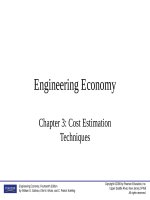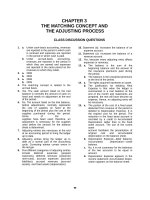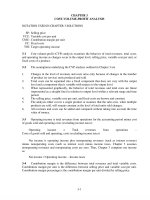Accounting26th ch 03
Bạn đang xem bản rút gọn của tài liệu. Xem và tải ngay bản đầy đủ của tài liệu tại đây (330.43 KB, 12 trang )
CHAPTER
3
The Adjusting Process
Warren
Reeve
Duchac
©2016
human/iStock/360/Getty Images
Accounting
26e
Nature of the Adjusting Process
(slide 1 of 2)
•
•
The accounting period concept requires that revenues
and expenses be reported in the proper period.
Under the accrual basis of accounting, revenues are
reported on the income statement in the period in
which they are earned.
o
o
•
For example, revenue is reported when the services are
provided to customers.
Cash may or may not be received from customers during
this period.
The accounting concept supporting this reporting of
revenues is called the revenue recognition concept.
Nature of the Adjusting Process
(slide 2 of 2)
•
•
•
Under accrual accounting, revenues are recognized when
services have been performed or products have been delivered
to customers. Revenue is measured as assets received, such as
cash or accounts receivable, in exchange for a service or
product. This process of recording revenues is called revenue
recognition.
The accounting concept supporting reporting revenues and
related expenses in the same period is called the matching
concept.
Under the cash basis of accounting, revenues and expenses
are reported on the income statement in the period in which
cash is received or paid.
The Adjusting Process
(slide 1 of 2)
•
Under the accrual basis, some of the accounts need
updating at the end of the accounting period for the
following reasons:
o
o
o
Some expenses are not recorded daily.
Some revenues and expenses are incurred as time passes
rather than as separate transactions.
Some revenues and expenses may be unrecorded.
The Adjusting Process
(slide 2 of 2)
•
•
The analysis and updating of accounts at the end of
the period before the financial statements are
prepared is called the adjusting process.
The journal entries that bring the accounts up to date
at the end of the accounting period are called
adjusting entries.
Types of Accounts Requiring Adjustment
•
The following basic types of accounts require
adjusting entries:
o
o
o
o
Prepaid expenses are the advance payment of future
expenses and are recorded as assets when cash is paid.
Unearned revenues are the advance receipt of future
revenues and are recorded as liabilities when cash is
received.
Accrued revenues are unrecorded revenues that have been
earned and for which cash has yet to be received.
Accrued expenses are unrecorded expenses that have
been incurred and for which cash has yet to be paid.
Depreciation Expense
(slide 1 of 4)
•
•
•
•
Fixed assets, or plant assets, are physical resources
that are owned and used by a business and are
permanent or have a long life.
As time passes, a fixed asset loses its ability to
provide useful services. This decrease in usefulness is
called depreciation.
All fixed assets, except land, lose their usefulness and,
thus, are said to depreciate.
As a fixed asset depreciates, a portion of its cost
should be recorded as an expense. This periodic
expense is called depreciation expense.
Depreciation Expense
(slide 2 of 4)
•
•
The fixed asset account is not decreased (credited)
when making the related adjusting entry. This is
because both the original cost of a fixed asset and
the depreciation recorded since its purchase are
reported on the balance sheet. Instead, an account
entitled Accumulated Depreciation is increased
(credited).
Accumulated depreciation accounts are called contra
accounts, or contra asset accounts.
Depreciation Expense
(slide 3 of 4)
•
Normal titles for fixed asset accounts and their
related contra asset accounts are as follows:
Depreciation Expense
(slide 4 of 4)
•
•
The difference between the original cost of the office
equipment and the balance in the accumulated
depreciation—office equipment account is called the
book value of the asset (or net book value).
It is computed as follows:
Book Value of Asset = Cost of the Asset – Accumulated Depreciation of Asset
Adjusted Trial Balance
•
The purpose of the adjusted trial balance is to verify
the equality of the total debit and credit balances
before the financial statements are prepared.
Financial Analysis and Interpretation:
Vertical Analysis
•
Comparing each item in a financial statement with a
total amount from the same statement is referred to
as vertical analysis.









